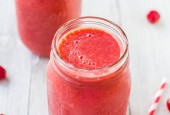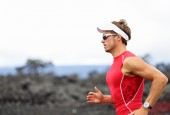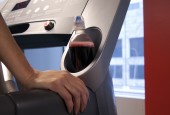Cooling the Fire of Inflammation to Maximize Your Workouts

The way you eat and live can help you get the most out of your exercise and cool inflammation, too.
Thank you to ChooseCherries.com for inviting me to contribute this article—and with pleasure. My professional opinions, suggestions, and taste buds are my own.
We know that exercise has so many benefits. It helps improve your heart health, builds strength, boosts your immune system and it lifts your mood. It helps manage blood sugar and energy, and of course, it burns calories. But did you know that exercise creates inflammation? (Yikes!) At the same time that it provides a wide range of benefits, exercise can also stir up inflammation and even cause muscle soreness. (Ouch!) That’s where your healthy lifestyle and a smart recovery routine come to the rescue.
5 Phases of Anti-Inflammation for exercise.
- The overall diet. Eating a plant-based diet–one that is high in fruits and vegetables, beans, whole grains, nuts and seeds–is the basis of an anti-inflammatory diet. Certain foods have been shown to have particular benefits to post-exercise recovery when consumed frequently in the day-to-day diet between workouts. Several studies, on runners and also cyclists, have shown that when athletes drink Montmorency tart cherry juice or consume Montmorency tart cherries in other forms several days or a week prior to an event, as well as the day of and after, they experience less inflammation and oxidative stress compared to a control drink. And it’s so easy to include Montmorency tart cherries into your day – whether in smoothies, in Greek yogurt, trail mixes or as concentrate. Some research has also shown that incorporating ginger into the diet in the days before intense exercise can reduce pain and inflammation.
- Pre-exercise. Depending on the type of exercise, it’s important to be well-hydrated and fueled prior to—but not too much too close to the start of—exercise. For endurance exercise lasting 60 or more minutes, consuming a light snack with some carbs and protein about 45-60 minutes before exercise is a good plan. Some research has shown that consuming beet juice concentrate during the time prior to exercise can help the body use oxygen more efficiently during exercise, ultimately getting better performance for the effort! For exercise less than 60 minutes, no special pre-exercise fuel is required, but make sure you’ve had a meal or snack within the past couple hours and don’t eat right before you start.
- During Exercise. This is the time to focus primarily on hydrating, and if your exercise is longer, to focus on carbohydrates and electrolytes, too. The goal is to fuel the workout you are doing and provide a ready-source of blood sugar during the longer workouts. If your workout is hard but shorter, focus on hydration to keep the blood flow circulating and your body temperature in check.
- Post Exercise (Recovery). This is the time to rehydrate and replenish with smart choices to speed your recovery and minimize pain and inflammation. Within 30-90 minutes after intense or long exercise, consume some carbohydrates and protein together along with water and electrolytes. This could be something tasty and simple like low fat chocolate milk or a Montmorency tart cherry protein smoothie. In two studies, researchers found that runners who drank Montmorency tart cherry juice before and after long-distance races experienced a faster recovery of strength compared to those who drank a control beverage. A post-exercise alternative could also consist of a whole foods snack or meal like a salty-sweet-tart trail mix of almonds, dried Montmorency tart cherries, and salted sunflower seeds or a complete meal like a turkey-stuffed whole grain pita with veggies, both of which offer that carbohydrate and protein combination.
- Recovery is “Precovery”. Recovery from exercise is definitely more than just food. It really includes the practices that ensure you’re ready and feeling energized to exercise again tomorrow, too. In addition to a routine of smart anti-inflammatory foods, cooling down after exercise, stretching, soothing the body with cool baths and healing lotions, and getting adequate rest are all important parts to promote a heathy and anti-inflammatory environment.
References:
Bell PG, et al. Nutrients, 2014.
Bowtell JL, et al. Med Sci Sports Exerc, 2011.
Connolly DA, et al. Br J Sports Med, 2006.
Ferguson SK, et al. Nitric Oxide, 2014
Ferguson SK, et al. Respir Physiol Neurobiol, 2013.
Howatson G, et al. Scand J Med Sci Sports, 2010.
Kuehl KS, et al. J Int Soc Sports Nutr, 2010.
Wendy Bazilian, drPH, MA, RD
Wendy Bazilian is a doctor of public health, registered dietitian and American College of Sports Medicine certified Exercise Physiologist in San Diego, California. She works in sports nutrition, is an advisor to the spa industry and co-owns Bazilian’s Health Clinic with her husband and business partner, Dr. Jason Bazilian. Dr. Wendy is an expert consultant to the Cherry Marketing Institute and is author of The SuperFoodsRx Diet (Rodale).
Follow her on Facebook at www.facebook.com/bazilians.




